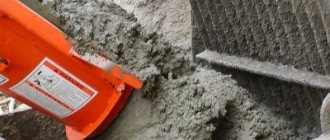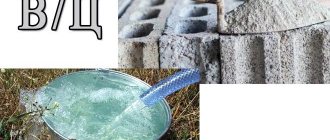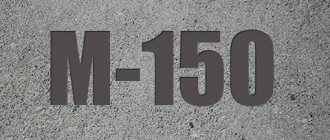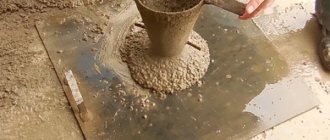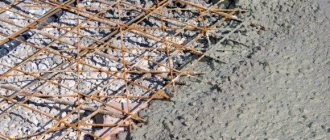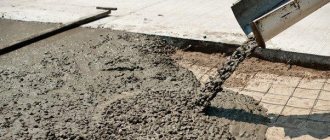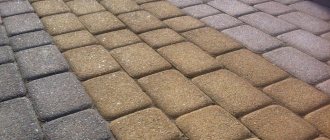The quality of work associated with laying concrete depends on the efficiency of compaction of the working mixture. When concreting floors, forming screeds and pouring mortar into formwork, professional builders compact liquid concrete with a special tool. The vibrating screed helps remove air inclusions from the concrete mass, extending the service life of the monolith, increasing wear resistance, strengthening and leveling the surface. Thanks to its simple design, it is easy to make it yourself, saving money.
Floating electric screed
Vibrating screed for laying concrete - purpose, scope of use and design
Popular among professional builders, a vibratory screed is a special device that resembles a regular rule with a vibration motor. The displacement of the center of mass during accelerated rotation of the rotor causes vibration of the working surface. The metal structure is made in the form of a frame made of hollow profiles.
Purpose of the vibrating screed:
- transmission of low-frequency vibrations through the concrete surface deep into the mass;
- formation of a flat concrete base when moving the device.
Depending on the volume of construction work, various types of tools can be used:
- professional equipment purchased in a store;
- vibrating screed, made with your own hands at home.
The slats differ in design features, as well as in the size of the working platform. For example, a feature of the sectional design is the ability to change the length of the working surface, and the floating one is the ability to adjust the angular position of the working handle.
Vibrating screed EV-270A
The use of vibration compactors allows builders to solve a range of problems associated with laying concrete :
- pour floors;
- arrange sites;
- concrete screed;
- ensure horizontal road surfaces;
- build pedestrian crossings;
- build bridges.
The rail has a simple design. It consists of the following nodes :
- a metal platform, the working surface of which transmits vibration to the concrete;
- a small-sized drive device, which is a source of low-frequency vibrations;
- a cantilever handle, thanks to which the operator moves the rack.
Vibrating screeds are designed for the following purposes:
- accelerated removal of moisture from the massif after laying concrete;
- increasing the homogeneity of the concrete mixture;
- removing air inclusions from concrete;
- increasing the strength properties of the monolith;
- ensuring the horizontal surface of the concrete.
As a result of the transmission of low-frequency vibrations through vibration, performance indicators change:
- strength increases;
Vibrating screed for concrete with guides
- wear resistance increases;
- the service life increases;
- density increases;
- improves appearance and surface quality.
Compared with industrial grouting devices and large grinding machines, homemade vibrating lathe is widely used in private construction due to the following advantages:
- versatility;
- compactness;
- functionality;
- practicality;
- reliability.
Vibrating slats are used on open construction sites, as well as on objects to which there is no power supply.
Why do concrete surfaces need a trowel?
A concrete trowel is a corrective tool. Its function is to smooth and level cement-sand mixtures. The industry produces several types of smoothers:
- channel - their purpose is leveling and simple correction of plastic mixtures of cement and sand that have not yet had time to harden;
- scraper - their purpose is to remove excess aqueous sand-cement components after vibratory ramming, when a liquid called laitance appears on the surface;
- rack - used for processing small surfaces.
Smoothing devices have different modifications. To ensure a perfectly smooth working surface, use a sole made of steel with a high carbon content. Lightweight irons are made of thin profiled aluminum. Blades made of magnesium alloy have good smoothness and wear resistance.
To prevent the blade from digging into the concrete floor, its edges are rounded. The telescopic concrete trowel is equipped with articulated joints for maneuverability.
Homemade vibrating screed - types of special tools
Vibration compactors are classified according to the following characteristics:
- design features;
- area of use;
- drive station power;
- metal structure material;
- the size of the site.
Do-it-yourself vibrating screed for laying concrete.
The devices also differ :
- amplitude of oscillations. The frequency of vibration depends on the mass of the eccentric and the design of the drive;
- weight. As the mass of the device increases, the depth that is subject to compaction increases;
- productivity. The most effective seals are those that transmit an increased level of vibration at low speeds;
- cost. Products from well-known manufacturers and professional tools have an increased price.
Vibratory ramming work can be carried out:
- indoors. An electric floating vibration screed is used;
- on an open construction site. A floating petrol vibration screed is used.
The oscillation generator can operate from various sources:
- electricity. The connection can be made to a household power supply, an electric generator or a battery. They are characterized by noiselessness, environmental safety, versatility and affordable price;
Gasoline vibrating screed - gasoline. Petrol driven racks can only be used on an open construction site. Features: increased power, efficiency, autonomy. Productivity depends on the weight of the vibrating tool.
The following types of devices are used to perform tasks of vibratory compaction of solid concrete::
- vibrating screed floating. Floating platform equipment is a lightweight design for fine leveling. Installed directly on the surface to be treated. With a platform length of up to five meters, the tool compacts the massif to a depth of up to 20 cm. Features of the floating type slats are low weight and ease of maintenance;
- telescopic vibrating screed for concrete. This is a device whose movement is carried out only along special guides. Has a working platform more than 6 meters long. The design allows you to increase the length of the working part to improve the performance of the vibration compaction. Low frequency oscillations penetrate into the array to a depth of 0.3 m;
- sectional vibrating screed. It consists of individual elements, the design of which allows you to increase the length of the working surface up to 30 cm, which increases the area processed in one go. The increased mass of the metal structure provides an increased depth of vibration compaction. Universal equipment is used for large-scale construction work;
- aluminum vibration screed. For laying concrete with your own hands, such a tool is indispensable, thanks to the light weight of the aluminum frame. The device, made of a lightweight profile, can be carried on a construction site by one worker. Aluminum vibrating tools can easily slide along guides and also “float” independently on concrete.
Application of the Atlas Copco BT90 modular vibrating screed
There are also reversible units that can change the direction of movement.
Concrete smoothing tools
After pouring the concrete screed into the wooden structure, leveling it and compacting it, tools are used to clean the surface. At the same time as cleaning, excess moisture is removed, all irregularities are removed, and air is released from the bubbles.
Pros and cons of manual smoothers
The advantages of manual smoothers include their availability for independent production from scrap materials, low price, and ease of performing independent actions.
The disadvantages are that a hand-made trowel is used only in small areas. The device has poor maneuverability, limited freedom of movement and low speed of work.
When choosing ironing devices, it is necessary to take into account the size of the areas to be processed, the speed required to complete the intended amount of work and, of course, the cost. For small spaces, you can make a smoothing tool yourself. To quickly work on large areas, it is better to rent a trowel.
Features of telescopic options
Telescopic options include devices with the ability to adjust the length of the handle, equipped with rotating mechanisms. Thanks to them, the handle can rotate in different directions. There are models that include a high-frequency vibration motor.
Homemade vibrating screed for concrete - specifics of use
Despite the simplicity of the design, follow certain rules when working with a vibrating compactor:
- check the operation of the equipment before starting;
- mount, if necessary, guides at the zero level;
- use a lath with a power corresponding to the thickness of the concrete layer;
- pour concrete mortar onto the base two centimeters above the level of the guides;
- start the vibration installation and gradually move the device;
- control the invariance of the position of the beacons during the operation of the rack;
- add small portions of concrete mixture in areas of subsidence;
- clean the metal structure from adhering solution;
- Clean up any defects on the finished surface after the concrete has hardened.
Compliance with these rules will ensure the quality of the formed surface and make it easier to work with the tool.
Rules for working with a vibrating screed
The vibrating screed is an extremely convenient and easy-to-use tool, but for comfortable work you must follow several important rules:
- Before each use, carefully check the tool for serviceability.
- Prepare special clothing, boots and gloves.
- Carefully attach heavy vibrating screeds to guides that are positioned exactly horizontally.
- Fill the holes and recesses remaining after filling with mortar to the required level;
- After completing the work, carefully clean the vibrating screed from the solution;
- After the solution has hardened, remove minor irregularities with a grinding machine.
How to make a vibrating screed yourself
To make a vibrating power tool, prepare the following materials and equipment:
- metal profile for frame assembly;
Testing a vibrating screed for pouring a floor
- plates and corners for making a platform;
- vibrator with fasteners;
- blanks for the future handle;
- power cable;
- electric drill;
- grinder;
- welding machine.
Produce according to the following algorithm:
- Prepare the blanks.
- Weld a metal frame.
- Weld the handle to the frame.
- Attach the vibration motor.
- Connect the power cord.
After applying voltage, check the reliability of the assembly.
Do-it-yourself vibrating screed for concrete - optimal parameters
When making a small device for household needs, pay attention to the following nuances:
- the length of the working part, which should not exceed 2–2.5 m;
- drive power, which corresponds to 1.2–1.5 kW.
The guides are installed level, which avoids unevenness of the poured base
Before production begins, you should decide on the design features and develop a drawing.
